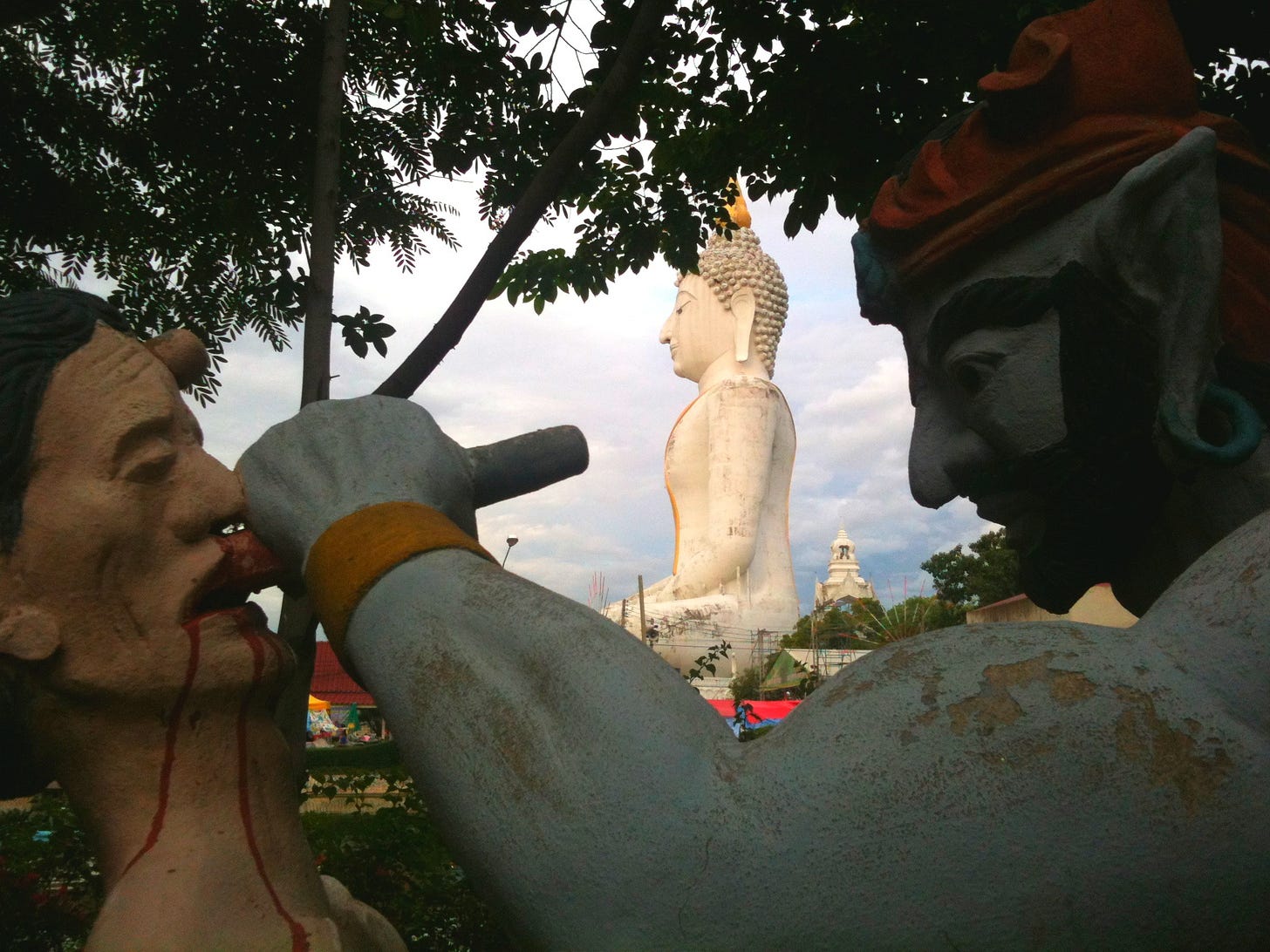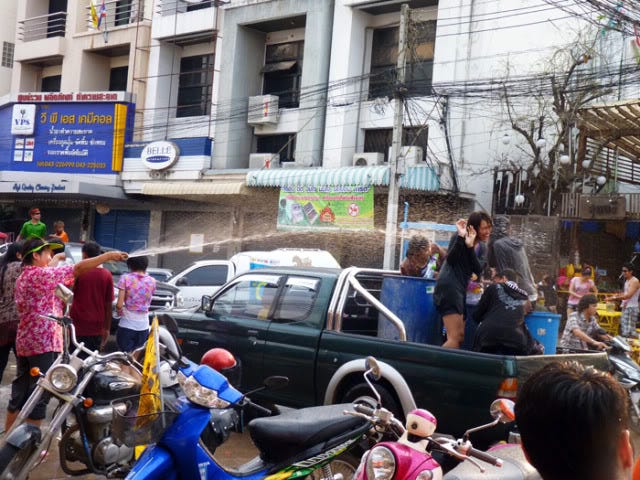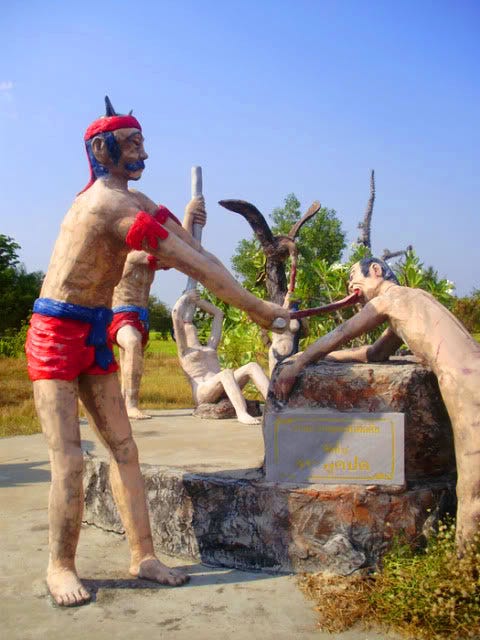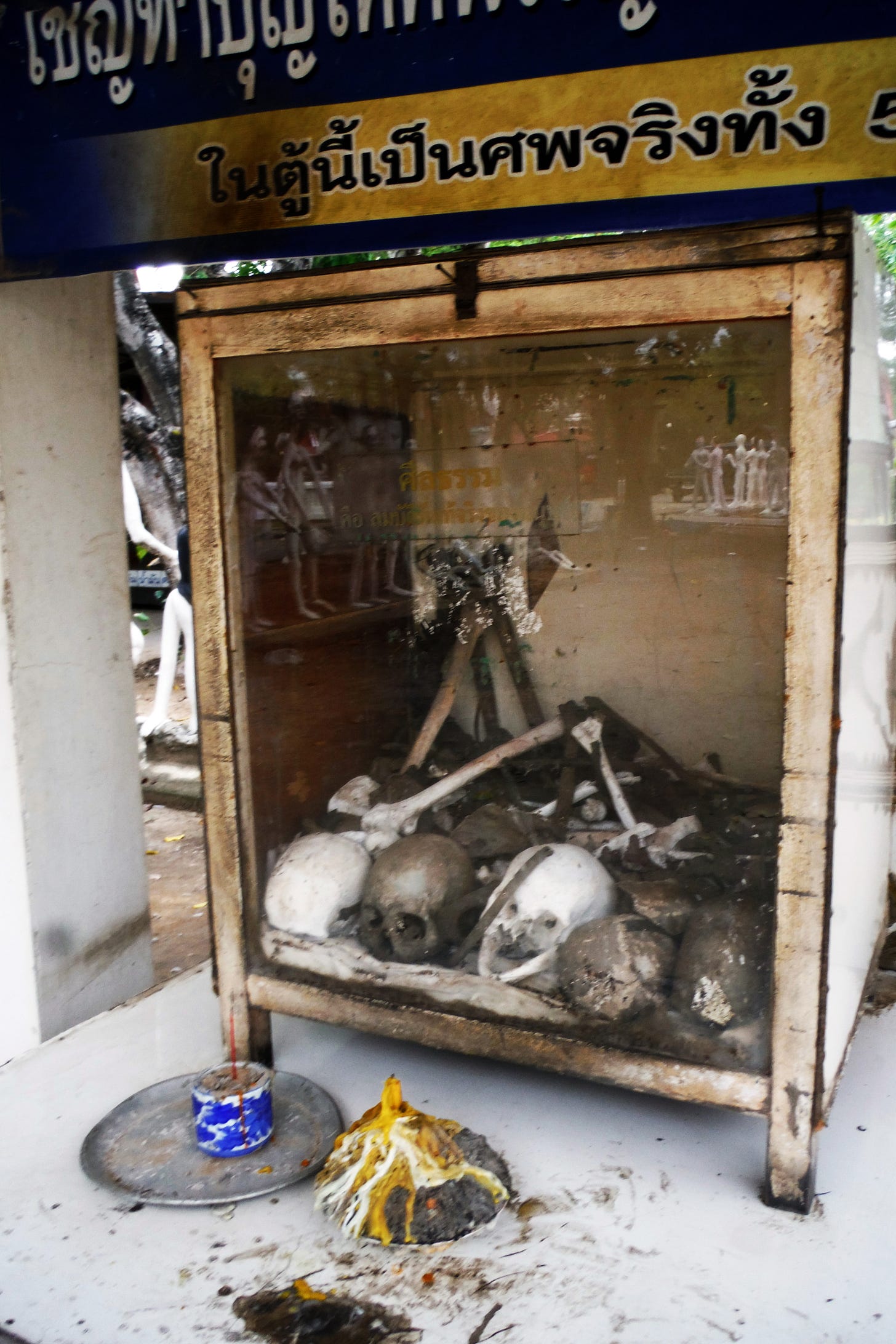Naraka Part II: A Buddhist Hell Road Trip Around Thailand
A photo tour of four hell parks with maps included!

To learn more about hell in Buddhism and the different areas of hell, check out my article, "Naraka Part I: The 8 "Major Hells" in Buddhism & Their Gruesome Punishments." You don't need to read "Naraka Part I" to understand "Part II," it just adds more context.
Isaan is a beautiful region that embodies the soul of Thailand. This northeastern region is made up of charming small towns, farmlands, national parks, ancient sites, supernatural festivals, and lush mountains that remind me of something out of Jurassic Park. It’s for good reason since dinosaurs once roamed that part of the earth.
People from Isaan are also the friendliest in the country and deserve all the credit for Thailand's nickname, "The Land of Smiles."
I first visited Isaan not long after moving to Bangkok 16 years ago. I made friends with a group of funny, cynical hipsters from Thailand and North America who had impeccable taste in music and movies. We would go on road trips whenever we could and explored lesser-known areas of Thailand together.
For my first Songkran, the Thai New Year, which happens every spring around April, we headed to Khon Kaen, one of four large cities in Isaan. We spent Songkran binge drinking, getting into water fights, dancing, and nearly getting hit by passing trucks.

My friends dropped acid, but I declined due to having two horrific mushroom trips in my mid-20s that made me swear off all hallucinogens except for ecstasy. (I'm 100% sober now.)
Once we recovered from the festivities, we explored the city and intended to check out a dinosaur museum, but we ended up spotting a unique-looking temple from the highway and decided to stop and take a closer look.
At the time, Wat Thung Setthi was still being built. Even in its early stages, it looked more like a palace in a SE Asian fairy tale than a Buddhist temple. Its uniqueness is due to the mix of Thai, Tibetan, Arabic, Chinese, and European style architecture.
I had no idea there were hells in Buddhism, let alone physical Buddhist hell parks until I saw one while exploring Wat Thung Setthi. Two looming statues as tall as trees greeted us at the entrance to this hell.
One was of a monstrous man with sickly grey skin, enormous hands, massive testicles, a pinhole mouth, and micropenis. Next to him was a matching grey woman with long, pendulous breasts, bloodshot eyes, and an extended tongue. Like most of the statues at the hell park, they looked to be suffering greatly.
These corpse-like giants are called pret or preta, which are hungry ghosts mentioned in Buddhism, Taoism, and Hinduism. They're doomed to suffer extreme thirst and hunger for eternity.
A spiritual website, called Pahuyuth, explains the spiritual and cultural significance of these hungry ghosts:
According to Thai belief, a person with a deficit of good deeds is assigned to a certain level of hell after death until the debt is settled. A pret has so much karma on it that it can never be reborn in the human world, but is stranded in the underworld, leading to eternal suffering. It is tall, has long hair, a long neck, a protruding belly, and a mouth as small as a needle, so he never gets enough to eat.
The Phi Pret is a bad-tempered and aggressive spirit that you can hear whistling at night and who is looking for someone who will end its sufferings. They are part of Buddhist mythology rather than specifically Thai, and the name is related to the Sanskrit word Preta (the same spirit in Hindu mythology). In China, this is the 'hungry spirit', and there is an annual festival in his honor.
Some Thai parents will scare their children by telling them they will become a pret if they lie or swear. Scaring the shit out of kids by telling them they’ll either become a ghost or get eaten by one if they don’t behave is normal in Thai culture. It's more prevalent among people from Isaan and other rural parts of Thailand—especially among nannies and grandmothers.
I was immediately amazed, excited, and intrigued by these huge, deformed sculptures. Thailand is the perfect country to visit if you enjoy exploring supernatural, death-related, and esoteric sites, which if you're reading The Spooky Tourist, you do.
Beyond the pret guards was an entire park with massive statues depicting various forms of suffering and torture that your consciousness would endure if you committed certain immoral acts during your time as a human and earned bad karma.

The gorey statues of tortured beings are a material embodiment of Naraka, which translates to "hell" in Sanskrit. These parks are all over Thailand, and even in other countries in SE Asia.
Once I experienced my first Buddhist hell, I had to visit as many as I could. There's something comforting and beautiful about them.
Buddhist hells are not huge tourist attractions since they're gruesome and not well-known to outsiders. Dark tourists who are well acquainted with Thailand might visit the more popular hell, but there are so many in the country with little to nothing written about them in English or even Thai.
That's why I think it's important to document the hell parks I've visited. In this article, I will take you on a virtual Buddhist hell road trip to four different hell parks in Thailand, with maps included. Two sites on this list are well-known among seasoned spooky tourists, but two aren't.
You'll notice the word wat in the Thai name of each location. This is because wat means "temple" in Thai. All the hell parks in Thailand are next to a Buddhist temple and free of charge.
1) Naraka (aka The Hell Outdoor Museum) next to Wat Thung Setthi in Khon Kaen
As I mentioned in the intro, I stumbled across the Hell Outdoor Museum (love the name!) when Wat Thung Setthi was still being built. Recent photos from a blog called TravelFeed show that it has a more official entrance now with a sign that reads "Welcome To Hell" in English and Thai.
When I was there 16 years ago, there was no official welcome to hell. My friends and I were greeted by two massive pret statues followed by an array of hellish sculptures.
The signs by each sculpture have English translations now, but back then, they were only in Thai. They describe what each punishment is for.
Each sin ranges from abusing drugs and alcohol to murder and even committing adultery.
The adultery tree is my favorite Naraka torture method because of how massive the sculpture is. It always amuses me that nearly every adult in Thailand belongs on that tree, given that Thailand consistently tops surveys as the country with the most cheaters.
I like the area of Naraka where animal abusers go. Beings will be reborn with animal heads and burned alive in a giant wok while animals bite at them and demons stab them with pitchforks.
The Hell Outdoor Museum also had a massive Nāga statue with seven heads.
Nāgas are serpent deities in Hinduism and Buddhism who live in bodies of water and can take human form. They guard important things such as temples, treasure, and even the Buddha himself. They're my favorite deity and otherwordly creature.
Most Buddhist hell parks in Thailand have a judgment scene where newly dead beings kneel before Yama, the King of Hell, who then decides whether to send those beings to an area of Naraka or reward them with good future lives.
Khon Kaen is a very underrated part of Thailand, so this little Hell Museum is not well-known. Very little is written about it. I love Isaan and hope to go back to visit soon. There are so many amazing Buddhist hells parks and murals hidden away there as well as incredible festivals like the Nāga Fireball Festival.
2) Wat Samai Kongka in Koh Phangan
In the south of Thailand, there's a beautiful island called Koh Phangan where you can find soft, white sand, a clear blue sea, and lush jungles filled with wild coconut and papaya trees.
This island is famous for its monthly Full Moon Parties on Haad Rin Beach but there's another, calmer, New Age side with yoga studios, meditation centers, and vegan restaurants called Srithanu.
I lived in Strithanu for two and a half years and had some intense experiences, both good and bad. While living there, I found a small Buddhist hell in the courtyard of a temple called Wat Sami Kongka and would go there often. A date even took me there once, not knowing I loved Buddhist hells. I think he was trying to shock me and was a bit surprised to see me smiling and happily taking photos and videos.
This Buddhist hell is small but still has some cool sculptures like the cauldron decorated with skulls or the tall pret statues with bloody belly buttons and long tongues.
It even had a small adultery tree! How cute!
Since this is such a small Buddhist hell, and getting to Koh Phangan is a giant pain in the ass, it's not worth going out of your way just to see it, but the island itself is beautiful and has very intense energy. I recommend visiting to enjoy the serene beaches and spectacular sunsets, as well as this little hell. Just watch out for the yoga and tantra sex cults in Srithanu!
3) The Wat Saensuk Hell Garden in Chonburi
I went to this Buddhist hell by myself nine years ago. The bus from the Ekkamai station in Bangkok to Chonburi Province was only 80 baht. ($2.37) It took about an hour and a half to get there and was a smooth, scenic ride. Even though it was nine years ago, I doubt the price of the bus trip has gone up very much. It's very cheap to travel around Thailand by bus, van, and train.
The taxi ride to the temple cost me more than the bus trip from Bangkok. The driver charged 150 baht which I'm sure was the farang (foreigner) price, but it's still a very cheap trip.
Right when I entered the hell garden, I was greeted by a Yama judgment display with a plaque that explained what is was. This Buddhist hell had a story about Reverend Malaya, who was one of the Buddha’s disciplines. He went to Naraka to save the beings trapped there.
The Wat Saensuk Hell Garden is large and feels like an actual park where you can sit down on a bench and bask in the brutal scenes of otherwordly torment and torture. As one does.
The pret statues were massive, even taller than the nearby trees.
I enjoyed the area filled with statues of animal-headed figures, each representing a different punishment for their past actions. For example, someone who was jealous was reborn with a rabbit's head, while another addicted to drugs took the form of a being with a prawn's head.
I appreciated that the plaques explaining each statue had English translations too. The descriptions were very dramatic and funny.
Thai signs in English always have spelling and grammar errors, which I find cute. It’s because they're direct translations and are not adjusted to fit English grammar rules. Thai signmakers don’t seem to use spellcheck either.
One of my favorite sculptures didn’t have any explanation and was better without one. It featured a headless entity with their face on their chest and stomach, being restrained by the demon of the underworld. It was a total mood.
Other sculptures were very graphic like demons sawing someone in half.
Another sculpture depicted a woman having her mid-section crushed because she had an abortion.
Abortion used to be illegal in Thailand due to the Buddhist belief that it is taking a life, but it became legal in February 2021 for pregnancies up to 12 weeks. It was determined that it was unconstitutional to make abortion completely illegal. Thailand respects reproductive rights.
In the park of the park, were statues with animal heads praying and asking for forgiveness for their wrongdoings. Beings in Naraka can reincarnate into a better life if they complete the time assigned to them in Naraka (usually millions or even trillions of years) or if a human makes merit on their behalf in the material world.
A sign nearby explains the conclusion of Reverend Malaya’s journey to Buddhist hell.
Reverend Malaya went to the Netherworld to save all the hell beings from sin and came back to tell their relatives to make merit by donating offering dedicated to the deceased.
Presumably the suffering hell beings were saved. So this Buddhist hell story has a happy ending.
I enjoyed the Wat Saensuk Hell Garden because it's big and the trip from Bangkok is pleasant and cheap. It's worth checking out!
I have a video of the Wat Saensuk Hell Garden on my YouTube channel. I would like to go back and reshoot it with a better-quality camera.
4) Wat Phai Rong Wua, The Suphan Buri Hell Temple in Suphan Buri
Suphan Buri is a two-hour drive from Bangkok. I shared a private taxi with two fellow spooky tourists to get there. I shot a YouTube video of this Buddhist hell but it looks like I filmed it with a potato because I did. I really need to go back to reshoot it and experience this incredible place again.
At the entrance, my friends and I were greeted by a giant demon holding a staff with a skull in one hand, and in their other hand was the neck of a tormented naked being with their arms ripped out. It really set the mood.
My first thought when I entered the Suphan Buri Hell Temple was, "Damn, that’s a lot of hell!"
This is the biggest hell park in Thailand and possibly even the world. There are other Buddhist hells in SE Asia, but I don't know of any that are anywhere near the size of the Hell Temple.
This is next-level hell. If you're only able to go to one Naraka park in Thailand, this is the one you need to visit!
There were so many sculptures as soon as I walked in, that I had a hard time figuring out what to take photos and videos of. I was bombarded by tormented statues tortured in numerous ways with the reasons for their torment painted across their bodies in Thai.
The sculpture of a couple trapped in a 69 position was fascinating. This hell park had a lot of unique sculptures that I hadn’t seen in any other hell. You have to start getting inventive with your punishments when you’re making hundreds of sculptures.
There was also a morbid fortune-telling game where people walked up a raised platform and tossed coins into a Naraka sculpture that had beings burning in a giant cauldron.
Inside were small, black bowls rotating around a wheel with different fortunes written on them in Thai like "good luck" and "rich." Some of the bowls had strange things written on them like "witch” and “illegal fortune teller.”
It felt like I was at a Buddhist Hell theme park.
The adultery tree at the Suphan Buri Hell Temple is massive and there were two of them! Pictures and videos do not do them justice, you need to experience them in real life.
When you’ve been to a few Buddhist hells, you'll notice that each park has a unique style to its sculptures.
The statues here were more cartoonish-looking, but also a lot bloodier.
There was an area dozens of tormented beings who looked like kid's drawings. They had deformities and open wounds all over their bodies. It felt like I was seeing a cool art installation. I love dark, twisted art.
The pret statues looked like long skeletons with pale, emaciated bodies. Their groin areas were anatomically correct and a bit too realistic for my liking.
It's normal for Thai families, especially in the rural part of Thailand, to take their kids to these parks to scare them into behaving. Most of the children I have seen at the Naraka park just thought the statues were funny and treated their visit to the hell park as a normal outing.

Towards the back of the park, was a cabinet with real human bones from five corpses and a sign that read:
Please make merit for the deceased without relatives according to your faith.
Thai people have a lot of respect for the dead and will leave offerings in areas where people died, even if they didn’t know them personally. I like that they do that.
Just like at Wat Saensuk, statues of people with animal heads prayed to a monk, whom I assume to be Reverend Malaya, seeking to improve their karma.
Nearby, you can visit some nice temples with giant Buddhas. I like the shot of a demon stabbing a being in the face framing a big Buddha behind them. It’s the cover image for this article.
You can spend all day at the Suphan Buri Hell Temple and not see everything. There's so much going on. It's my favorite hell park in the world. I can’t wait to go back with a better camera!
These four sites are just a few of the many Buddhist hell parks in Thailand. I've compiled a list of additional Buddhist hells I still need to visit.
Wat Santi Nikhom in Lamphang
Wat Si Don Mun in Chiang Mai
Wat Mae Kaet Noi Hell Garden in Chiang Mai (Really cool one!)
Wat Rong Khun in Chiang Mai
Wat Phuet Udom in Phatum Thani
Wat Pak Bo in Bangkok (Naraka Mural)
Wat Pariwat in Bangkok
Wat Kai in Ayuttthaya
Wat Muang in Ang Thong
Wat Tham Tapan in Phang Nga
If you have an opportunity to come to Thailand one day and enjoy visiting strange places, you might want to add one or more of these hell parks to your itinerary. You must see the Suphan Buri Hell Temple!





















































